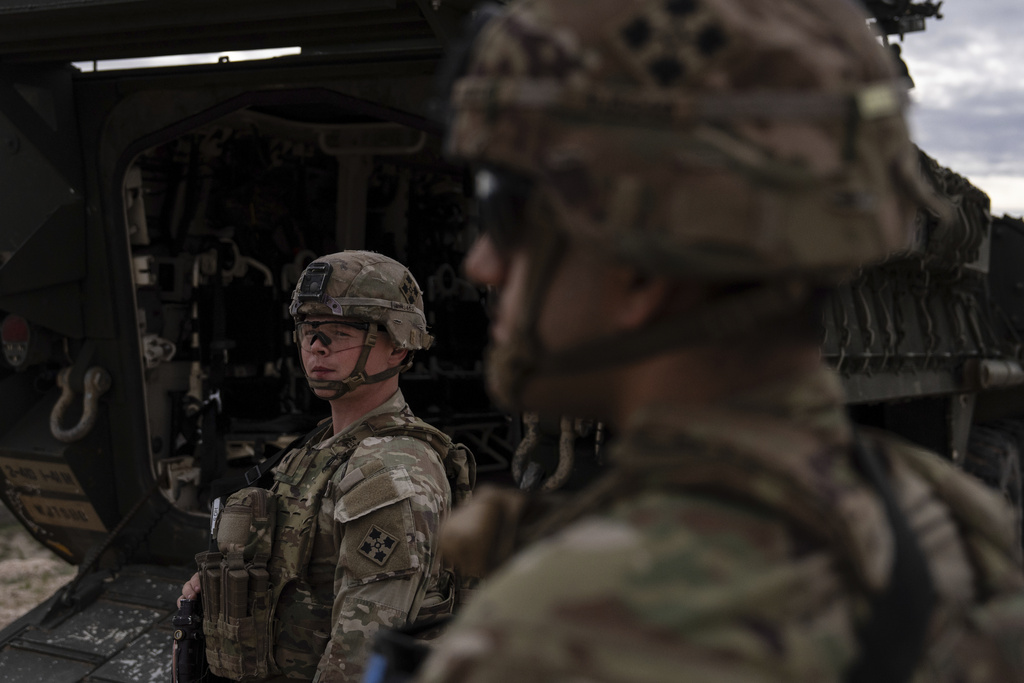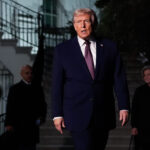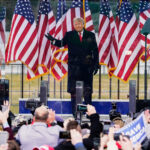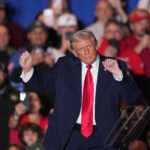Trump Expands Military Role in Border Security \ Newslooks \ Washington DC \ Mary Sidiqi \ Evening Edition \ President Donald Trump has deployed thousands of military personnel to the southern U.S. border to deter illegal crossings. Troops now operate in designated militarized zones, working alongside Border Patrol. Though crossings have declined, the mission continues to expand with no end in sight.
Quick Looks
- Trump triples troop presence at U.S.-Mexico border
- 7,600 troops deployed; all military branches involved
- Army scouts, drones, helicopters patrol key crossing points
- Military presence credited with deterring illegal entry
- New command center coordinates mission in Arizona
- Troops authorized to detain trespassers on military land
- Marine engineers expanding border barrier infrastructure
- Critics warn deployment blurs legal, constitutional boundaries
- Drones monitor deserts, urban areas for “got-aways”
- Posse Comitatus Act challenged by expanded military role
Deep Look
President Donald Trump has significantly escalated his administration’s use of military power in immigration enforcement, turning what was once a peripheral role into a full-scale deployment of armed forces at the U.S.-Mexico border. What began as a support role during his first term has transformed into a permanent and far-reaching mission involving over 7,600 active-duty and National Guard troops—and counting.
In a striking display of force, every branch of the U.S. military is now represented at the southern border, from Army scouts patrolling desert terrain to Marine engineers reinforcing fencing with razor wire to Air Force units operating surveillance drones. The military’s footprint spans key states like Arizona, Texas, and California, with operational command guided from a new hub in southern Arizona near Fort Huachuca.
At the center of this strategy is a newly fortified command center, formerly a community hall, now transformed into a digital “war room” staffed by battalion commanders, intelligence analysts, and logistics officers. Oversized monitors display real-time drone footage, troop movement maps, and detection alerts. The command post coordinates joint operations with U.S. Customs and Border Protection (CBP), focusing on known high-traffic corridors used by smugglers and unauthorized migrants.
This unprecedented military expansion comes at a paradoxical moment: illegal crossings have dropped to a 60-year low, according to CBP data. And yet, the Trump administration has argued that the decline is a direct result of the military’s aggressive posture — one that relies on constant visibility, rapid response, and uncompromising deterrence.
In Nogales, Arizona, the presence of uniformed soldiers with combat gear is becoming routine. During a recent patrol, a U.S. Army scout spotted a man perched atop the border wall. Before the man could climb down between the coils of razor wire, Border Patrol agents closed in. He fled back into Mexico. “These sightings don’t happen often,” said Army Sgt. Ana Harker-Molina, a 24-year-old Panamanian immigrant who became a U.S. citizen and now serves on the border mission. “But our presence alone makes people think twice.”
Harker-Molina’s sentiment captures the administration’s philosophy: deterrence through visibility. And that strategy extends far beyond the walls of Nogales. The border force includes 117 Stryker armored vehicles, over three dozen helicopters, and long-range surveillance drones capable of scanning hundreds of miles of desert. These tools are crucial in tracking “got-aways” — individuals who elude detection and vanish into urban centers or remote wilderness areas.
Army Maj. Gen. Scott Naumann, who leads the mission, says the military’s speed and flexibility provide a crucial advantage over civilian agencies. “We can fly into incredibly remote areas,” he said. “There’s no union contract. No shift limitations. We can operate around the clock.” Naumann’s teams can deploy anywhere along the 2,000-mile border within hours, using air support and intelligence assets to interdict smugglers and unauthorized crossers in real-time.
The push for increased military presence comes alongside Trump’s efforts to boost civilian enforcement. The administration recently authorized the hiring of 3,000 new Border Patrol agents, sweetened by $10,000 in signing and retention bonuses. Yet despite the declining border apprehension numbers, officials insist that now is not the time to pull back.
“There’s a seasonal lull,” Naumann explained, referring to the intense summer heat in desert regions. “But once temperatures fall, we expect crossings to spike again. Our job is to stay ahead of that curve.”
Beyond physical deterrence, the legal landscape is shifting. Since April, the administration has designated certain areas of the southern border as “militarized zones.” These zones enable troops to apprehend and detain individuals accused of trespassing on military property, including Army, Air Force, and Navy installations. While civilian law enforcement has traditionally handled immigration enforcement, Trump’s military escalation represents a significant reinterpretation of authority.
The move has sparked concern among constitutional scholars and legal watchdogs. Critics argue that the expansion blurs the line between military and civilian law enforcement, potentially violating the Posse Comitatus Act — an 1878 law that restricts the military’s ability to act as domestic police.
“This operation treads into a gray constitutional area,” said Dan Maurer, a law professor and retired Army judge advocate. “It breaks historical norms. Whether it violates the law depends on the specifics, but it’s definitely outside the traditional scope of military operations on U.S. soil.”
Joshua Kastenberg, a former Air Force judge and now professor at the University of New Mexico School of Law, adds that while the military can detain trespassers on federal bases, “using troops to conduct broader immigration enforcement pushes the limits of what’s legally and ethically acceptable.”
But for President Trump, that ambiguity is part of the point. The border mission has become a symbolic and strategic pillar of his second-term agenda — one aimed at energizing his base with a show of power, while also fulfilling a long-standing campaign promise to end illegal immigration.
Military assets are now supporting immigration enforcement beyond the border as well. Troops have helped guard federal buildings during protests in cities like Los Angeles, assisted ICE operations in Florida, and been prepped to support detention centers housed on military bases. This broad use of military support reflects what Maurer calls a “muscular immigration policy” designed to demonstrate resolve.
Yet critics warn the costs — financial, legal, and reputational — could be steep. The mission is operating with no defined end date, raising concerns over long-term militarization of civil functions and the erosion of democratic checks and balances. Human rights advocates argue that the increased use of force and surveillance creates a climate of fear for migrants, asylum-seekers, and border communities.
Still, the Trump administration appears undeterred. With the midterms looming and immigration once again front and center in national discourse, the military presence at the border is unlikely to recede soon.
Supporters argue the strategy is working. Drones are intercepting smugglers. Got-away rates are down. Cross-border incursions are rarer. “We are having success,” Naumann emphasized. “The mission is trending in the right direction.”
Yet even some within the military express mixed feelings. “We signed up to defend the country,” said one anonymous officer embedded in the Arizona sector. “But now we’re navigating a political battlefield, not just a geographic one.”
As the operation continues to evolve, the militarization of the border may prove to be one of the most enduring legacies of Trump’s immigration agenda — reshaping not only policy, but the very role of the U.S. military in American life.
Trump Expands Military Trump Expands Military Trump Expands Military Trump Expands Military







